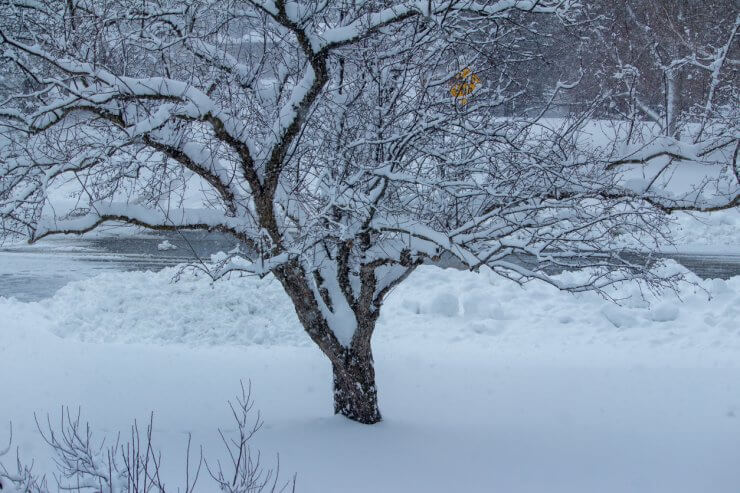
Pruned and protected apple tree in winter
Your apple trees will benefit from a little TLC to get through the winter.
Final Harvest
Be sure you’ve picked the tree clean and removed any fallen apples from around the tree.
Insulation
Tree Guard: A tree guard, wrapped around the trunk of a young tree, will help insulate it from the cold and protect it from getting sun scald. This is a common injury to young trees. The sun warms the trunk up during the day, and then the temperature plummets at night. That puts the tree trunk at risk of splitting. The tree guard reflects the sun’s rays and reduces the extreme temperature fluctuations. When your tree is too big for a tree guard, you can make a 50/50 solution of water and white latex paint, and paint the tree trunk from the lowest branch down to the ground.
Mulch: Mulch provides insulation for the roots. As an added benefit, it will break down over the season, adding nutrients to the soil. Good mulch choices include:
- wood chips
- pine needles
- bark mulch
- evergreen boughs
- straw (not hay)
You can also use leaves or compost, but keep in mind that these may freeze. You might want to mix leaves or compost in with one of the other insulators.
That cozy organic blanket is going to be incredibly attractive to local wildlife, so it’s a good idea to sprinkle in some deer and rabbit repellent to keep critters away from your tree’s tender bark—which should be mostly protected by the tree guard.
Water
You shouldn’t need to water your tree unless you are experiencing a winter drought. Keep in mind that dry roots are at higher risk of injury than moist roots.
Fertilize
You do not need to apply any fertilizer to your trees during the winter.
Prune
Do plan to do a little pruning while your tree is dormant. See Nurturing Your Apple Trees for details.
Snow

Snow-covered apple tree
Don’t worry about snow; it’s actually a great insulator! If you live in an area that’s prone to ice storms, however, you might want to put a fence of chicken wire or a frame around your tree so you can drape a tarp or frost cloth over it. But if you get mostly snow, your tree should be fine.
Container Trees
For your apple trees growing in containers, the same preparations apply. If you can move your tree, move it to a spot out of the wind, wrap the trunk with a tree guard, and cover the soil with mulch (don’t forget the deer and rabbit repellent). If you’ve been training your tree to grow along a wall or fence, wrap the trunk and add mulch and pest repellent to the base. Keep in mind that you’ll be pruning sometime during the winter, so you need access to the branches.
Don’t let the soil in your container dry out; check it about once a week. The mulch should help retain moisture, and any snow you get will provide both insulation and water. But you don’t want your tree’s roots to dry out, so set a schedule to check on your container trees.
Have you successfully overwintered your apple trees? Please share your tips with us.


 Previous
Previous

